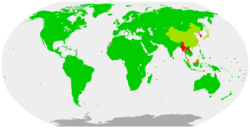| Convention concerning the Abolition of Forced Labour | |
|---|---|
 Contracting and in force states Contracting but not in force States that denounced the convention Non-contracting states | |
| Signed | 25 June 1957 |
| Effective | 17 January 1959 |
| Condition | 2 ratifications |
| Parties | 176 [1] (178 ratifications less two denunciations) |
| Depositary | Director-General of the International Labour Office |
| Languages | French and English |
Abolition of Forced Labour Convention, 1957, the full title of which is Convention concerning the Abolition of Forced Labour, 1957 (No. 105), is one of the eight ILO fundamental conventions of the International Labour Organization, which cancels certain forms of forced labour still allowed under the Forced Labour Convention of 1930, such as punishment for strikes and as a punishment for holding certain political views.
Contents
In order to implement the 1930 Forced Labour Convention and the 1957 Abolition of Forced Labour Convention, the Special Action Programme to Combat Forced Labour was set up.